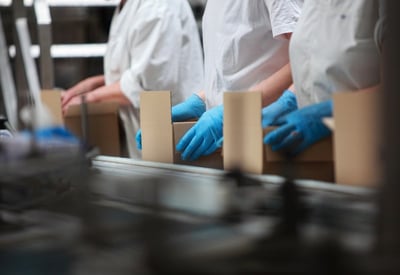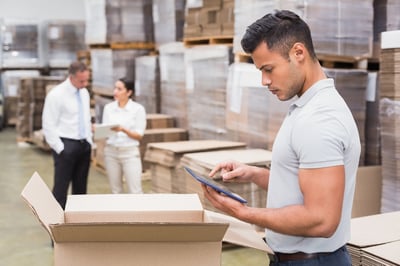In-House Packaging: To Automate Or Not?
As a company running an in-house packaging line, you’ve got to admit that it has been a complicated couple of years.
Between months of unexpected downtime due to the COVID pandemic, the labor shortage of 2021, the ever given container ship debacle, and now the great resignation, running an in-house packaging line has been anything but easy.
It seems that your supply chain has been taking hit after hit, month after month, for some time now.
As we head closer to 2022, you want to make sure that you make the best choices for your in-house packaging line as we dive deeper into this new world and the significant changes that have come with it.
In many ways, business will never be the same again. But, for a company with an in-house packaging line, things are even harder to predict when choosing which actions should be taken to keep your production running.
But what exactly does that look like? Should you hire more line workers? Or would it be better to partially automate your packaging line?
With the ever-looming complexities of COVID variants and the possibility of other unexpected black swan events, perhaps it makes more sense to fully automate. But is automation right for your business?
Truth be told, there are no simple answers to these questions. Each of the options mentioned above has its pros and cons. And those variables will undoubtedly change from one scenario to the next.
How can you be sure that you are making the right choices for the safety of your employees, clients, and business partners?
Navigating a semi-post-pandemic ecosystem may seem like an insurmountable challenge, but life and business must go on.
While we can’t predict the future, we can look back on recent events and make educated guesses about the best course of action.
With over six decades in the packaging industry, Industrial Packaging has traversed the stormy seas of change within this ecosystem to great success. And we can help your business to do the same.
This article will review your options for running an in-house packaging line in 2022 and beyond. With the information in this article, you will be able to select the best options for the safety and success of your people, products, and brands.

To Automate Or Not? That Is The Question!
This is perhaps, one of the biggest questions of our current age. We are living in unprecedented times of technological advancement, human evolution, and disruptive, transformational experiences that will change business for the foreseeable future.
With the rise of new digital communication capabilities such as those promised by way of the metaverse, we collectively find ourselves on the precipice of a new world.
A world in which the IoT will integrate not only with our cell phones, tablets, and computers, but also our homes, appliances, and yes, even our packaging machinery and robotics.
As such, any company with an in-house packaging line that is nearing the time in which they need to upgrade their equipment and labor protocols must make a decision. And the question that must be answered at this time is, to automate or not?
That is the question.
But this is not a simple question to answer. Furthermore, automation may or may not be a good idea for your business, depending on where you are currently at with your in-house packaging line.
Right now, you have three main options when it comes to setting up your packaging line for success in safety and profitability. We will review these three options below.
Need help buying automated packaging machinery?

1. Minimal Automation With An Expanded Temporary Work Force
Your first option when it comes to your in-house packaging line is to keep your current equipment or upgrade to new or refurbished models of the same machinery while expanding your workforce.
Depending on the age of your equipment and the financial investment in expanding your human labor, this may be the least expensive option currently available to you.
And, by expanding your workforce, you are creating new jobs for the local economy. With that being said, there is no guarantee that you will be able to source the required workers.
As we enter the fourth quarter of 2021, many companies continue to fail at finding new workers due to the labor shortage that all businesses have been fighting this year. And this comes on the back of the arrival of the great resignation.
Hold up. The great resignation? What’s that?
More commonly known as the “Big Quit,” the Great Resignation is the continual trend of employees voluntarily quitting their jobs. This has been occurring from spring 2021 to the present day as a response to the COVID pandemic. The name “Great Resignation” is most commonly attributed to a man named Anthony Klotz, a professor of management who teaches at Mays Business School of Texas A&M University.
No one knows for sure how long this trend will last, but one thing is for sure. At this current time, it is a risk to lean heavily on human labor as American businesses battle to gain and keep good help and quality employees.
However, as unemployment and pandemic relief benefits have largely come to an end, many workers are returning to the workforce and seeking employment.
Only time will tell if choosing to stick with mainly human labor VS automation will make the most sense. It is advised that you develop a network of temp work agencies that you can work with if you primarily rely on human labor.
This will allow you to access workers as needed and increase the likelihood of sourcing laborers to achieve your business goals.

2. Semi-Automation With Reduced Human Labor
Your next option is to partially automate your packaging line. This would be the combination of semi or fully automated packaging machines and collaborative robots that work in conjunction with human laborers.
By semi or fully automating your packaging line, you can decrease the number of human laborers in your warehouse.
This will result in better performance in hitting or exceeding your KPIs. Automation is also good for reducing the likelihood of transmitting viruses such as a COVID variant, the flu, or the common cold.
However, you may or may not be able to make the financial investments required to purchase semi or fully automated equipment and robots.
If you wish to purchase this machinery but cannot afford to buy it outright, you may want to consider leasing as a secondary option.
If you qualify for leasing or other forms of financing, you can pay smaller monthly payments while paying off your new equipment.
If you are unsure if you are eligible for leasing or financing, you will want to speak with a packaging machinery specialist one-on-one.
They will be able to help you quickly identify if you are qualified for these options or not.

3. Fully Automating Your Packaging Line
Finally, you have the option of completely automating your packaging line. This would include all fully automated packaging machines in addition to a collection of collaborative robots and a skeleton crew of human employees.
A small group of equipment operators and mechanical technicians will be required to implement the running of the machinery and oversee day-to-day activities.
These employees will also be responsible for occasional preventative maintenance and repair work as needed.
This is by far one of the most expensive and complicated options to implement. But, once you are up and running, you will be able to have a small team run the entire operation.
And, as the technology for fully automated equipment evolves with IoT integration, eventually, you will be able to do all of this from the comfort of an office or, perhaps, the beach.

Should You Automate Your Packaging Line?
As much as I hate to say it, the answer to this question is, it depends. I know that is probably not what you want to hear, but it is the truth.
Ancient Rome was not built in a day, and if it were, it probably would have collapsed a lot sooner. When dealing with something as advanced and complicated as mechanical automation and robotics, it is imperative that you speak with a packaging machinery expert.
They will be able to help you figure out if semi, full, or minimal automation is the best choice for your in-house packaging line.

How Can Automation Benefit Your Business?
With the information above, you should have everything you need to decide if automation is the correct choice for your in-house packaging line or not.
But, you are probably wondering, how can automation benefit your business? Would you like to learn about the various ways in which automation can improve your packaging line?
Suppose you want to learn more about the benefits of automated packaging machinery and robotics for your company. In that case, you will want to consider reading this sister article, Why Robotic Packaging Automation is the Future.
With the information in this article, you will be able to decide if automated packaging machinery and robotics are right for your business or not.
About Nathan Dube
As the Digital Marketing Specialist at Industrial Packaging, I am honored to create content for such a phenomenal company and work with one of the greatest teams in the Packaging Industry. Whether creating a video, writing blog posts or generating other pieces of content and multimedia, I am always excited to help educate and inspire our prospects and clients to reach their highest potential in regards to their packaging processes and needs.




